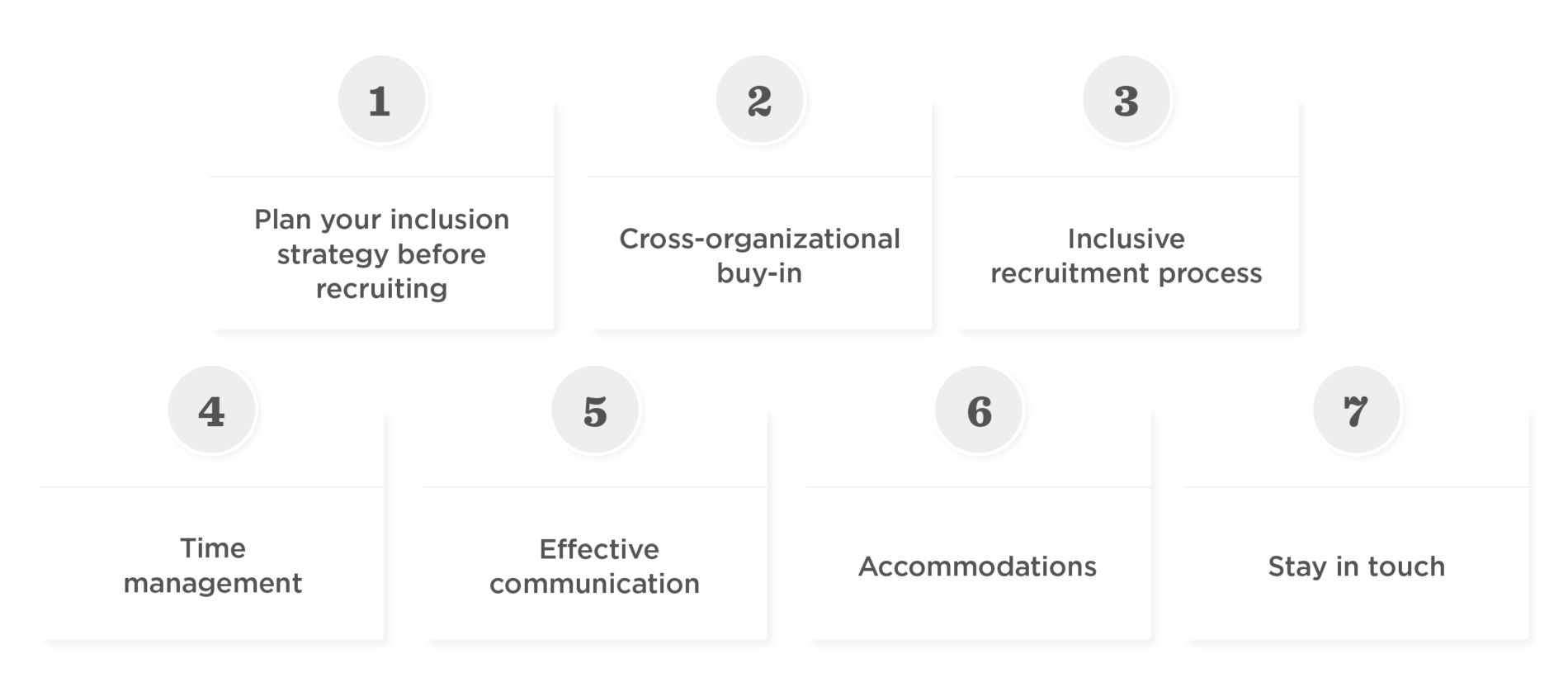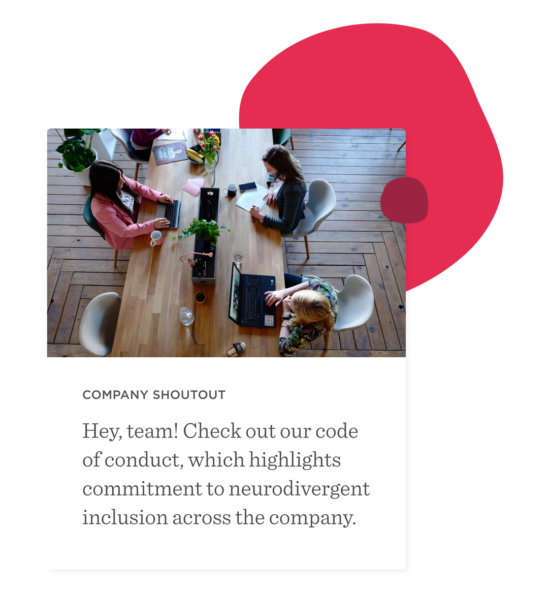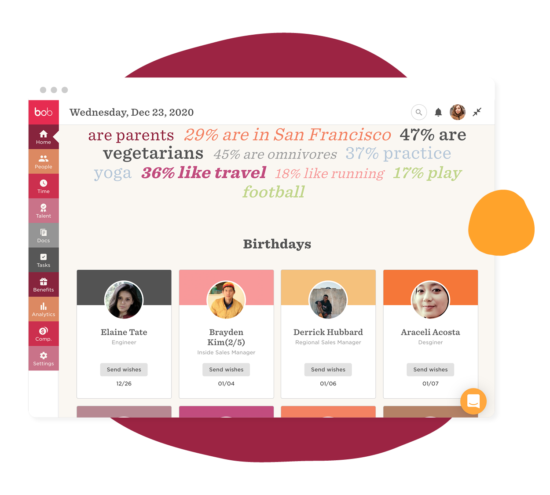Why this guide?
The modern workplace is more progressive, with HR leaders making strides in fostering diversity, equity, and inclusion.
But one area where there is still a lot of work to be done is in the inclusion of neurodivergent employees.
Diversity and inclusion are not just about gender and race. While improvements have been made in empowering employees from all walks of life, workplace programs towards gender diversity are the most common, with other groups receiving less focus.

Shining a light on neurodivergent inclusion
In one recent survey of American employees, 81% of respondents indicated that their workplace has a DE&I policy—but only about half of companies have disability-based programs (let alone a neurodivergent-focused program).
A recent poll in the UK by the Chartered Institute of Personnel and Development (CIPD) shows that this lag isn’t just an American issue. The need for better efforts at neurodivergent inclusion is apparent on both sides of the pond. 72% of HR professionals who responded don’t consider neurodiversity part of their DE&I policy, and 17% didn’t even know what “neurodiversity” means.
This is a huge oversight that can cost businesses a competitive edge.
Neurodivergent conditions such as autism spectrum condition (ASC), attention deficit and hyperactivity disorder (ADHD), dyslexia, and others, possess extraordinary skills, for example in pattern recognition, numbers, and memory. Companies with DE&I programs focused on neurodivergent candidates report increased innovation, employee engagement, productivity, and revenue.
While these candidates are often skilled, educated, and motivated, they are dramatically underrepresented in the workplace. The estimated rate of unemployment for autistic adults is 85%, and with 50,000 autistic adults entering the US job market every year, this is a huge potential pool of potential employees.
It’s also the right thing to do.
HR is in a unique position to set the tone and the culture towards accommodating neurodivergent individuals. Simple and low-cost adjustments to recruitment practices, work environment, and communication will give organizations access to a large, untapped pool of talent.
This guide explains neurodiversity and the benefits of recruiting neurodivergent candidates and outlines actionable strategies for fostering a more inclusive organizational culture.

What is neurodiversity?
Neurodiversity is a term used to describe the variety of human neurocognitive abilities. This recognizes that everyone has differences in how they learn and function, and most people have special talents and areas they struggle with.
For some of us, these differences are more pronounced. While neurodivergent individuals will likely possess unique strengths, they will also have similarly unique challenges. There is no one type of neurodivergent condition. And while many neurodivergent individuals experience less difficulty, for others, these conditions can be disabling and require special accommodation. This can make finding steady employment difficult.
Some of the currently recognized conditions include:
- Dyslexia
- Dyspraxia
- Dyscalculia
- Mental health
- Attention Deficit and Hyperactivity Disorder
- Tourette Syndrome
- Autism Spectrum Condition
- Asperger Syndrome
HR can make a difference
It is estimated that 15-20% of the population is neurodivergent and around 1 in 45 people is on the autistic spectrum. When implementing a plan for DE&I programs geared towards neurodivergent candidates, consider using the following three pillars in your strategy:
- Each neurodivergent individual is different and unique
Recognizing these differences and understanding that not all neurodivergent individuals will have the same traits or needs is the first step towards DE&I in the workplace. This will entail tailoring jobs, tasks, management, and the physical workspace to the employee’s unique needs.
- Standard processes and policies don’t work
Many neurodivergent people don’t have the skills typically sought after by top-tier companies. Focusing on communication skills, networking, emotional intelligence, and conformity to standard practices systematically screens out neurodivergent people—and this is both unjust and shortsighted.
- Small changes make a big difference
HR can make impactful changes with low-cost accommodations. Not every individual will need every accommodation, but here are some common ways that HR can promote neurodivergent DE&I:
- Adjusting recruitment and hiring practices for neurodivergent candidates
- Promoting workplace accessibility and making physical accommodations
- Providing adequate training for peers, management, and executives
- Developing a system for providing ongoing support
These small but important changes will open your organization’s doors to exceptional candidates and signal a culture of empathy and inclusion.

Benefits of neurodivergent inclusion
It is widely recognized that diverse and inclusive culture is good for business. Companies with gender and ethnically diverse leadership are significantly more profitable than their more homogenous counterparts, in part because diversity is also a driving force for innovation.
At the employee level, Deloitte Australia research has shown that inclusive teams outperform their peers by 80% in team-based assessments.
Promoting DE&I is also vital for fostering employee engagement and loyalty. One survey found that 66% of job seekers prioritize company culture when applying for a job. It is known that when employees feel appreciated and empowered, this contributes to vastly improved retention rates and a happier, more productive workforce.
While these numbers largely reflect DE&I programs that fail to adequately address the needs of neurodivergent employees, the benefits of neurodivergent inclusion are equally impressive.
According to the Harvard Business Review, a growing number of companies are reforming their HR processes to better access neurodivergent talent. The most long-running of these is SAP’s Autism at Work program. SAP CEO Christian Klein is quoted as saying that teams that include individuals with autism have reported a rise in patent applications, product innovation, and improved management skills and empathy. Launched in 2013, this program has become a model for other companies looking to do the same.
Some prominent companies that currently have neurodiversity initiatives include Microsoft, Dell, and JP Morgan—all have seen marked boosts in productivity, innovation, output quality, and employee retention. According to executive director and head of JP Morgan’s ‘Autism at Work’ program, James Mahoney, “Our autistic employees achieve, on average, 48% to 140% more work than their typical colleagues, depending on the roles.”
An added benefit of adjusting internal processes and standards is that it promotes a culture where every employee—including those that are not neurodivergent—is valued for their uniques talents and given support for their unique challenges. Managers learn to manage more effectively, and colleagues work better together as a team
Companies with HR at the leading edge of DE&I are swiftly recognizing that including neurodiversity in their policies is vital in propelling a healthy culture and boosting the bottom line.
How can HR leaders make an impact? Keep reading for some tried and true strategies.

HR strategies for neurodivergent inclusion

Before even planning or implementing your DE&I strategy, the first thing to do is research resources for recruitment and support.
Organizations looking to be more inclusive of neurodivergent individuals can team with government or nonprofit organizations experienced in working with people with disabilities, both for referral of potential candidates and for guidance.
- Plan your inclusion strategy before recruiting
It isn’t always effective to post a general job description when recruiting neurodivergent candidates, so make sure you know what you’re looking for beforehand. Utilize channels specific to the neurodivergent community when advertising job opportunities and build inclusion into the recruitment process:
- Take a step back and think about which areas of your company could potentially benefit from the types of skills neurodivergent candidates possess.
- Understand what roles a neurodivergent person would be best suited for, for example, in organization or data instead of customer-facing roles.
- Decide whether to create a new role specifically for the candidate or hire them into an existing position.
- Leverage associations with organizations for referrals once you’ve laid the groundwork.
- Cross-organizational buy-in
Culture trickles down from the top, so get managers and executives on board before initiating a neurodiversity inclusion program. Getting your people trained on how to interact with neurodivergent employees also shouldn’t wait until onboarding. Start introducing inclusion before hiring so that when neurodivergent candidates arrive in the office, accessibility and empathy are already built-in.
- Create opportunities to speak openly with teams and managers to explain why bringing a neurodivergent candidate on board will be beneficial.
- Offer awareness training to everyone from executives to colleagues to managers.
- Create resources and reference guides for all levels of staff to promote empathy and understanding.
- Inclusive recruitment process
The way most companies hire and onboard employees involve processes that are a stumbling block for neurodivergent individuals. Face-to-face interactions can be overwhelming, communication can be a challenge, and traits that are typically sought after like assertiveness, team work, and amiability aren’t actually typical unless you’re neurotypical.
HR can revolutionize how candidates are hired to promote neurodiversity in the workplace. Once a neurodivergent candidate is hired, HR also plays an important role in ensuring that employees receive the support that they need to succeed regardless of differences.
- Although neurodivergent people may excel in certain areas, most don’t interview well. Consider asking candidates to demonstrate their skills by doing a work-related task instead.
- Simplify your forms and interview questions to avoid confusion.
- Make sure all your policies are written clearly and as briefly as possible.
- Use images to illustrate duties where applicable.
- Offer appropriate, useful feedback to candidates.
- Time management
Consistency and routine are important to many neurodivergent individuals, ensuring that managers are adequately trained and sensitized to this need. It can take time to find the right rhythm, so encourage patience and empathy from teammates and managers.
- Give plenty of notice for meetings and changes.
- Let the employee sit out large meetings with many people participating and speaking simultaneously.
- Help the individual establish routines and build manageable timelines and methods of communication.
- Problem-solve issues together in a non-confrontational environment.
- Effective communication
Neurodivergent employees may miss nuances and subtleties, so keeping communication frequent, straightforward, and simple is critical to successful inclusion programs. This isn’t just for job descriptions; it’s a long-term integration strategy that requires ongoing effort and reevaluation.
- Use written communication and instruction—it is easier to process the information and minimizes the risk of misinterpretation. If possible, include images or other graphic depictions.
- Say exactly and literally what you mean.
- Don’t expect employees to understand unspoken social cues.
- Unexpected events can be disruptive. Explain changes clearly and transparently.
- Have an awareness of raised anxiety levels and be tactful (but clear) when providing feedback.
- Accommodations
Neurodivergent people may need workplace accommodations to foster their abilities and mitigate potential challenges. Neurodiversity often comes with sensory differences—lights and sounds that many of us find natural may be overwhelming and distracting.
The good news is that most accommodations, like subtler lighting, noise-canceling headphones, and locating the employee’s desk in a quieter area are not expensive but can make a world of difference for neurodivergent employees.
- Provide headphones to block out background noise and prevent auditory overstimulation.
- Avoid overly bright lights that can cause sensory overload.
- Consider letting the employee work different hours and focus on deliverables instead of attendance.
- Offer periodic desk assessments and rearrange seating as necessary.
- Ask employees how they are managing with their environment using specific questions: Are the screens too bright? Is the location where you are seated too busy? Is there enough storage for your personal items?
- Stay in touch
Neurodivergent employees may struggle with expressing themselves to HR or to their managers and coworkers. This is why ensuring ongoing communication and training is your responsibility—take the initiative and encourage management teams to do the same with regularly scheduled meetings or mechanisms encouraging neurodivergent employees to express themselves.
- Conduct regular one-on-ones to help you, managers, and colleagues understand neurodivergent team members better.
- Highlight employee support networks and similar resources clearly in the onboarding process and in company documents.
- Offer individualized support, including mentoring, coaching, counseling, or other forms of support, and ensure that these are offered regularly.
- Get insights on how your employees are doing with workspace questionnaires and satisfaction surveys.

Recommended For Further Reading
Conclusion
As the modern workplace moves in the direction of diversity, equity, and inclusion for all people regardless of gender or race, it’s important that HR not forget about including neurodiversity in their strategies and programs. This is, of course, the right thing to do. But, it is also the smart thing to do.
Neurodivergent inclusion is good for business. Higher productivity, enhanced employee loyalty and retention, positive brand awareness, and more innovation are all recognized benefits of DE&I efforts focused on neurodiversity. Now is the time to move the dial and build a more inclusive workplace—for everybody.

Meet Bob
We know how important it is to make holistic and culturally sensitive decisions about your people, especially in light of today’s modern workplace trends. That’s why we built Bob, a people management platform that fosters an inclusive culture and boosts employee satisfaction.
Remote and hybrid work can be a solution for a lot of the challenges facing neurodivergent employees. Bob is designed and developed for the way people work today—globally, remotely, and collaboratively—giving HR a platform to drive culture, two-way communication, engagement, performance, and compensation.